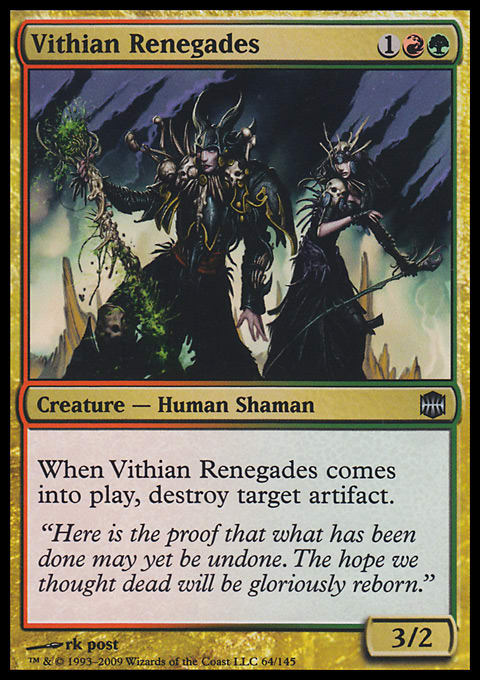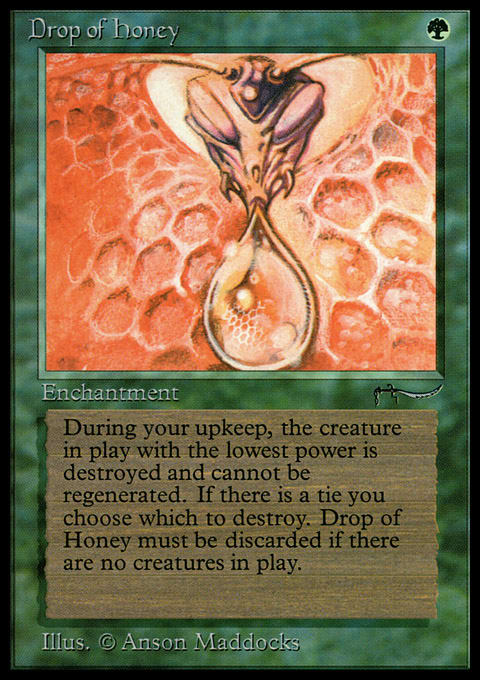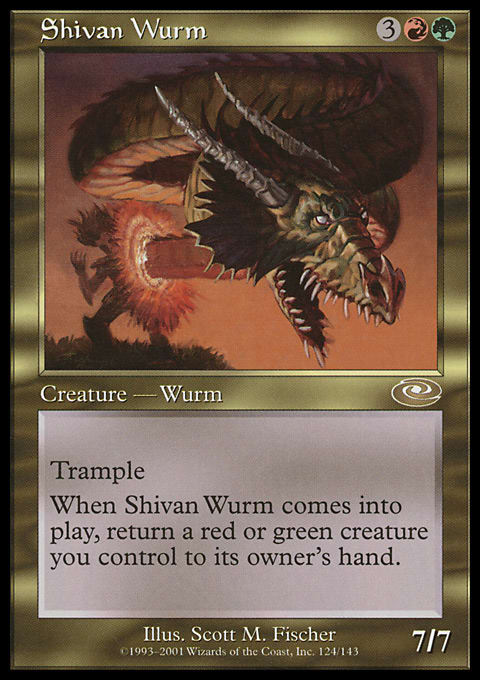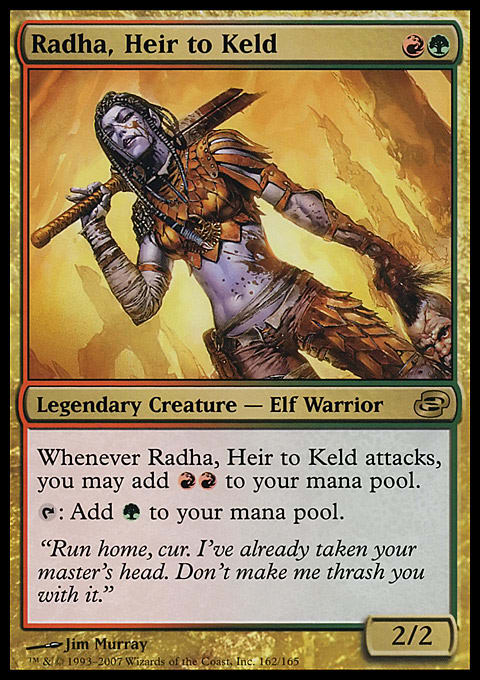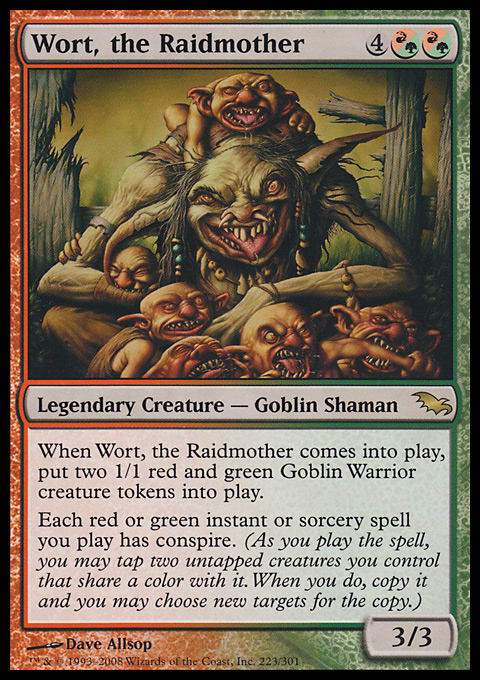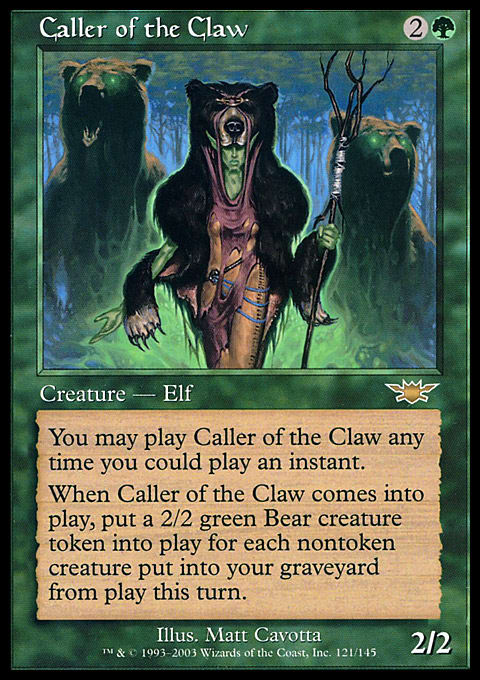The bad boys of Ravnica are back! Gruul brought the beatdown in Guildpact, and I can't wait to see the goodies we get in Gatecrash. For the uninitiated, here is everything you need to know about Gruul.
Strengths
The Gruul are the barbarians of Ravnica: If you’re sick of rules, logic, and personal hygiene, join the revolution and stick it to The Man!
- Dynamic Duo – Green is the color of ramp, and red is the color of explosive acceleration, so it shouldn’t be any surprise that Gruul is the most dynamic guild, and this extends to their creatures and even their philosophy. Gruul is the guild that comes out swinging while other colors are still lacing up their gloves: high power, haste, pump effects (Rubblehulk says, “Goodbye!”), and more! If your games are going too long, the solution lies here.
- Hulk Smash! – The Gruul are going to tell those Azorius fascists where they can stick their rules and structure and “civilization,” and mechanically, we can see this in Gruul’s drive for destruction. Artifacts, enchantments, and even lands can establish a framework that everyone at the table has to abide by—until the Gruul player blows them up. It’s not just that Gruul has the removal spells, but that they can get the effects without losing any tempo or card advantage whatsoever. If your metagame has shifted toward artifact acceleration and Equipment, put a Gruul deck together starting with Uktabi Orangutan, Viridian Shaman, Viridian Corrupter, Manic Vandal, Vithian Renegades, Oxidda Scrapmelter, Batterhorn, Acidic Slime, and Molder Slug. Between overwhelming the board with critters and taking a dump on your opponents’ best-laid plans, you’ll be well on your way to victory.
Gruul’s destruction is an important form of control; many successful aggro decks are aggro-control hybrids that disrupt your opponents so that they can't react to the beatdown until it’s too late. Check out Brandon Isleib’s Radha deck as well as my decklist at the end of the article for examples of Gruul’s disruption.
- The Punisher – Gruul decks don’t just blow up everyone’s artifacts and enchantments, they blow up everyone! While they don’t have quite the sadistic nihilism of the Rakdos, Gruul offers options such as Spellshock, Primal Order, and game-ending Earthquake and Hurricane variants. When you're trying to deal 40 damage to each opponent, and it’s silly to think that you can just rely on Tattermunge Maniacs and Kird Apes, noncreature spells that can deal large chunks of damage to the whole table are essential.
- The Zoo Crew – Red and green should not be dismissed as simple or simple-minded. Maybe the Gruul guild gives that impression, but there are a lot of interactions between these colors if you look below the surface. It’s hard to classify one-of effects—except that these miscellaneous cards are capable of totally taking your opponents by surprise because they’re expecting meat-and-potatoes aggro.1 Two of my favorite sixty-card decks are Gruul aggro with a surprising twist. One is built around the potentially infinite combo of Nature's Will and Aggravated Assault, and the other takes advantage of the synergy between Rite of Passage and Pyrohemia. Don’t take Gruul for granted!
Weaknesses
Red and green are doing better at drawing cards than ever before, but they still haven't overcome their main weaknesses in creature removal. Red is mainly limited to paying for X spells, and green usually has to kill opposing creatures through combat; together, they don’t really have any synergy in terms of dealing with creatures.
That’s why the aforementioned punisher spells are so important. Without those, Gruul has to rely on combat, a small number of kill spells (Aftershock and Beast Within chief among them), and the occasional niche ability such as Pandemonium, Ulvenwald Tracker, or Drop of Honey. The news isn’t all bad, but Gruul is more likely to be faced with creatures it can't deal with than any other color—which, interestingly enough, brings us back to square one, with X spells to the dome as the best solution to unkillable creatures.
Hidden Gems
Artifact Mutation – Artifact removal, creature generator and combat trick, this spell does it all!
Burning-Tree Shaman – Every deck uses activated abilities, which means everyone is going to feel the pain from the Shaman. Embrace the burn, and drop Burning-Tree Shaman as soon as possible—the damage will rack up quickly.
Decimate – Hull Breach, Relic Crush, and Fissure Vent are great two-for-ones, but Decimate is a targeted four-for-one. The only real problem I’ve found is that there sometimes aren’t enough enchantments to provide a target, but the risk is well worth it—there are always creatures, lands, and artifacts, and the ability to destroy any creature in these colors is so rare that you have to run it.
Dragonlair Spider – Instant army! I dropped a Dragonlair last night and managed to generate over a dozen Insect tokens with it—in a duel. The presence of a 5/6 blocker tends to stall the game a little, and the longer it stalls, the more you can clog the ground with tokens—which also have the effect of slowing your opponents down! Dragonlair Spider creates a positive spiral of time and dudes, either of which can be decisive. Additionally, swarms of attackers are particularly effective against planeswalkers (except Jace IV), Luminarch Ascension, and big beefy blockers.
Giant Trap Door Spider/Hunting Kavu – I talked about deterrence a couple of weeks ago and then remembered these two overlooked gems. 2/3s for 3 mana are decent on offense, but their real value is in deterring attacks, threatening to take away most of your opponents’ favorite toys permanently.
Horned Kavu/Shivan Wurm – These aren't game-changers, but with so many great enters-the-battlefield effects on red and green creatures, Gruul is in a great position to abuse the gating mechanic from Planeshift. Gating is a downside mechanic (usually on creatures) that requires you to bounce a creature of the same color to your hand when you cast it, and because it’s a downside mechanic, you can cast a strong creature at a discount. Horned Kavu is 3/4, which isn't exactly a gorilla, but you'll still have mana left over to equip it or cast another spell. Shivan Wurm is a 7/7 for 5 mana, and even by the standards of modern power creep, that’s a great deal. And Sparkcaster . . . well, they can’t all be winners.
Impromptu Raid/Killer Instinct – These cards can be great for tempo, allowing you to swing from out of the blue. If you find that aggro doesn’t work as well in your metagame because everyone is playing with Wrath effects, consider devoting a few extra slots to deck manipulation and taking advantage of this Gruuliest of mechanics. For more ideas, see the deck-building section below.
Mage Slayer – Aggro gold. This is only going to damage the defending player, and it doesn’t count as combat damage, but slaying opposing mages is the name of the game, and this is one of the best ways to do it.
Predatory Advantage – This is another tempo card that helps you to be the beatdown in a sweeper-heavy environment. You’ll always have a couple of creatures ready to attack during your turn—just add a Sword of Wreck and Face and climb right back into the driver’s seat!
Rumbling Slum – One of the best Gruul creatures from the first Ravnica block, The Slum Who Rumbles is an efficient beater who enables bloodthirst on every upkeep. There are few cards capable of dealing as much damage to a multiplayer table for only 4 mana!
Savage Twister – Here’s the closest thing to Wrath of God that Gruul has to offer. It isn’t great, but it gives you the option of blowing away your opponents’ weaker creatures and then swinging with your (theoretically beefier and therefore still alive) dudes.
Scuzzback Marauders – For aggro on a budget, here’s an efficient, recurring trampler.
Surge of Strength – Sometimes, the fact that your commander is really expensive can be an advantage. Surge of Strength was Wizards of the Coast’s first attempt at a “fixed” Berserk, and it might be a little pricey, but it takes a creature like Borborygmos to a whole ’nother level.
Vengeful Rebirth – One of the all-stars from my Kresh the Bloodbraided deck, this gives you a two-for-one plus whatever value you generate from the recurred spell. I’ve vengefully rebirthed a Violent Ultimatum more than once, but feel free to “just” regrow a huge beater and deal 6 damage to the most deserving target you can find.
Vexing Shusher – Counterspells are still a thing. Well, they were until you played the Shusher. If you have a lot of problems with counterspells, you might also consider Spellbreaker Behemoth.
Meet the Boss
Crap
Marhault Elsdragon – Rampage sounds great, but it has never been an effective combat mechanic.
Tuknir Deathlock – Here’s a weak body with a difficult casting cost and a disappointingly weak mechanic (that was moved into white soon after Legends).
The Lady of the Mountain – Technically, a 5/5 for 6 mana could be classed as fair-to-middlin’, but this card is: obsoleted by the next card on this list; clearly an Esper wizard, judging by the picture; and not remotely lady-looking. I’m not demanding a scantily-clad Boris Vallejo pin-up, but with all due respect to Richard Kane Ferguson, whom I love, The Androgynous Robed Figure on the Mountain is just not going to cut it.
Fair to Middlin’
Jerrard of the Closed Fist – Big beater is big.
Livonya Silone – Livonya Silone was my choice of commander when I built my first Gruul deck. She is an expensive 4/4, but first strike is useful, and legendary landwalk is almost unique. On top of that, her wicked RKF art makes her a total casual badass.
Sunastian Falconer – Here’s a reasonably-costed body with a Sol Ring attached. With so many great beaters that cost 7 or 8 mana, you can go like the clappers once you untap with the Falconer.
Radha, Heir to Keld – For my money, Radha for 2 is better than Falconer for 5, but they are similar. Radha invites a little more creativity in using her attack trigger, and as a replayable bear, she definitely does good things in a Voltron deck. I should point out, though, that while Radha may be at the helm of some very powerful decks, she is not inherently that strong, hence the rating.
Borborygmos – Bigger beater is bigger. Borborygmos, Unemployed Cyclops is bigger and badder than Jerrard of the Closed Fist, but the difference is really quantitative rather than qualitative. There may be some games you win because Borborygmos pumps your forces up to lethal size and some games in which he does his impression of a Slith Predator, gaining 5 or 6 counters and taking out most of your opponents. Most other times, he’ll be a near-vanilla beater outclassed by fancier commanders.
Just Johnnyable
Stangg – Stangg is among the most interesting of the Legends commanders. For 6 mana you get 6/8 in combined power and toughness, so you’re already ahead of the game. Stangg and his Stangg Twin copy token have some kind of twisted codependency thing going on, but that isn't all downside; token decks are full of ways to benefit from having more creatures in play, and Stangg provides extra sacrifice fodder, which has many uses (including synergy with another card on this list).
Borborygmos Enraged – He costs a little more and does a little more than old-school Borborygmos, and he doesn’t need any other creatures to work with. The main difference is that Borborygmos Enraged allows a little more buildaroundability, as being able to turn excess lands into Lightning Bolts leads you in new directions. For example, Seek the Horizon may become better than Explosive Vegetation, and with fewer lands being played from your hand, you might want to run Mana Flare and Heartbeat of Spring or even artifact accelerants such as Caged Sun and Gauntlet of Power.
Rosheen Meanderer – Rosheen builds are all about the X-Factor . . . not the inspired comic run by Peter David, but spells with an X in their casting costs. Find enough of those (you can start here), and a good Rosheen deck can put the fear of God into your playgroup. And failing that, a 4/4 for 4 is a very efficient beater. You can even load her up with Equipment . . . perhaps a Sigil of Distinction?
Thromok the Insatiable – You need to be running tokens hard to get Thromok humming, but my friend Chris has shown me it can be done (and a pilgrim named Ben dropped down to Seoul from the DMZ for just long enough to show me that it can be done with frightening speed and reliability). Chris considers his deck pretty simple, but even in the games in which he gets his butt kicked, it is pretty clear that he only needs a little bit more time to kill at least one of us, if not sweep the table. By the way, Warstorm Surge is the best friend a 49/49 commander ever had.
Ulasht, the Hate Seed – Thromok is just a Hellion, but Ulasht is a Hellion Hydra, so it’s no surprise that he (she?) offers enterprising Johnnies a lot more to work with. You can start with a weenie build, including tokens if you like, or focus on manipulating counters. You can even just run Ulasht as a disposable, spite-filled beater—drop him when you have enough other dudes on the table, and burst the hate-piñata if someone plays a sweeper. It’s a shame that you can’t remove his (its?) counters to damage a player, but that’s where the Johnny part comes in. Repercussion, Stuffy Doll, and Vicious Shadows occurred to me, but I’m sure you’ll think of something meaner.
Powerhouses
Wort, the Raidmother – Riku of Two Reflections taught the Commander community the value of copy effects, but Wort seems to be sadly underappreciated. All you have to do is tap Wort and one other creature to copy an instant or sorcery spell, which can be enough to get you . . . well . . . anything you like! Ramp, draw, removal, burn, and even creatures can all be achieved through instants and sorceries, which makes me wonder why I’ve never seen a Wort deck in the real.
Stonebrow, Krosan Hero – If you ask most people who is the best Overrun-type commander, I expect they would say Kamahl, Fist of Krosa (or his descendant Baru), but Stonebrow might actually be better. By coming down earlier and immediately giving your attackers a bonus, Stonebrow provides immediate tempo that is much harder for your opponents to disrupt than most other commanders.
Of course, your creatures have to be tramplers to benefit from Stonebrow, but that’s not hard—a lot of efficient beaters have trample, and you have a wide variety of other effects that grant it, from a localized Rancor to wider effects like Roughshod Mentor, Primal Rage, and Gruul War Plow.
Gruul Guidelines
Deck-building is never easy, even if you’re channeling your inner barbarian. Here are some ideas to get you started if you're new to Commander, or just new to Gruul:
- Tokens – Not exactly groundbreaking, I’ll admit, but it’s a potentially strong strategy all the same, especially with Thromok, Ulasht, or Wort as your commander. Both colors have plenty of ways to pump out creatures, pump them up en masse, and even benefit from them being swept away, such as Goblin Bombardment, Fresh Meat, and Caller of the Claw.
- Counters – There are a lot of different ways to put counters on your creatures and also to benefit from them. Rage Forger may be the most well-known, Champion of Lambholt and Skarrgan Pit-Skulk have a great counter-friendly mechanic, and I’ve had fun with cards like Apocalypse Hydra, Ion Storm, and Goblin Razerunners. The potential is endless!
- Cheatyface – I mentioned Impromptu Raid and Killer Instinct in the Hidden Gems section, but there are enough other cards in these colors to build a whole deck around. Cards that allow you to cheat cards into play from your hand include Lure of Prey, Dramatic Entrance, Quicksilver Amulet, Aether Rift, and Sneak Attack. Off the top of your deck, there is the well-known Lurking Predators and the barely-known Call of the Wild. If you’re relying on the top card of your library being a worthwhile creature, you need deck manipulation. That isn't exactly the strength of these colors, but you can still control your top-decks with Sylvan Library, Mirri's Guile, Preferred Selection, and Cream of the Crop. On top of that, there are a small number of scry effects in these colors (don’t forget Crystal Ball and perhaps Galvanoth) and various green tutors and regrowth effects that will put a card on top of your library. Many of these effects require you to sacrifice the cheated-in creature, so don’t forget Fecundity, Stalking Vengeance, and Perilous Forays, just so you have something to show for your efforts beyond the bruises on your opponent’s face.
- Punisher – Whether you want to punish your metagame for an overreliance on artifacts, enchantments, or specialty lands or you just want to smash everyone in the face as hard as you can until the game is over, Gruul provides a cornucopia of chaos.
As an example of the punisher type, here is my Livonya Silone deck: unrelenting aggro, strong disruption, and few noncreature targets for my opponents’ spot removal.
"Punisher Silone Commander"
- Commander (0)
- Creatures (37)
- 1 Acidic Slime
- 1 Apocalypse Hydra
- 1 Bloodbraid Elf
- 1 Bloodfire Colossus
- 1 Boartusk Liege
- 1 Boggart Ram-Gang
- 1 Brindle Shoat
- 1 Burning-Tree Shaman
- 1 Champion of Lambholt
- 1 Chartooth Cougar
- 1 Crimson Mage
- 1 Deus of Calamity
- 1 Dragon Broodmother
- 1 Dragonlair Spider
- 1 Dryad Sophisticate
- 1 Eternal Witness
- 1 Garruk's Packleader
- 1 Hydra Omnivore
- 1 Invader Parasite
- 1 Lord of Shatterskull Pass
- 1 Magmatic Force
- 1 Masked Admirers
- 1 Molder Slug
- 1 Moldgraf Monstrosity
- 1 Rumbling Slum
- 1 Spearbreaker Behemoth
- 1 Stalking Vengeance
- 1 Strangleroot Geist
- 1 Taurean Mauler
- 1 Valley Rannet
- 1 Vengevine
- 1 Vithian Renegades
- 1 Vorapede
- 1 Wilderness Elemental
- 1 Wolfir Silverheart
- 1 Livonya Silone
- 1 Rorix Bladewing
- Spells (23)
- 1 Beast Within
- 1 Deglamer
- 1 Fault Line
- 1 Inferno
- 1 Rack and Ruin
- 1 Reiterate
- 1 Relic Crush
- 1 Shattering Pulse
- 1 Squall Line
- 1 Word of Seizing
- 1 Aftershock
- 1 Boundless Realms
- 1 Cultivate
- 1 Decimate
- 1 Explosive Vegetation
- 1 Fissure Vent
- 1 Icefall
- 1 Insurrection
- 1 Kodama's Reach
- 1 Mass Mutiny
- 1 Recross the Paths
- 1 Skyshroud Claim
- 1 Tranquil Grove
- Lands (39)
- 14 Mountain
- 18 Forest
- 1 Contested Cliffs
- 1 Karplusan Forest
- 1 Kessig Wolf Run
- 1 Raging Ravine
- 1 Rootbound Crag
- 1 Stomping Ground
- 1 Valakut, the Molten Pinnacle
My goal here is to hit hard and fast and prevent my opponents from stabilizing. The creature count is high, and the list includes a lot of hasty creatures. I’m trying to maximize the damage that each creature can deal and/or their versatility.
The spells are as simple as it gets:
- Six ramp
- Ten spot removal (with as many two-for-ones as possible)
- Three theft
- Three mass damage
- One generic spell-copier
The removal mainly deals with enchantments and artifacts rather than creatures. If my opponents drop anything my creatures can't smash through, I can steal it or sweep the board. Worst-case scenario, I expect to be able to push the tempo of the game enough to create a lot of opportunities for my other opponents to finish each other off.
I hope that gives you a good idea of how Gruul rolls. I’ve been rocking R/G for as long as I’ve been playing, and it might be my favorite two-color combo (and undoubtedly my favorite nonblack guild). If you haven't shuffled up the Gruul, you’re missing out on a ton of fun!
1 Or, as Borborygmos would say, meat and eggs!
















